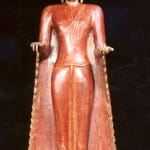Early Pagan Wooden Red Lacquer Sculpture of Buddha Standing, 12th Century CE - 13th Century CE
Wood
79.5
X.0217
Further images
-
(View a larger image of thumbnail 1
)

-
(View a larger image of thumbnail 2
)

-
(View a larger image of thumbnail 3
)

-
(View a larger image of thumbnail 4
)

-
(View a larger image of thumbnail 5
)

-
(View a larger image of thumbnail 6
)

-
(View a larger image of thumbnail 7
)

-
(View a larger image of thumbnail 8
)

The ancient capital of Pagan is among the most important historical and archaeological sites in modern Myanmar. Although the city was founded as early as the 9th Century A.D. along...
The ancient capital of Pagan is among the most important historical and archaeological sites in modern Myanmar. Although the city was founded as early as the 9th Century A.D. along a major bend of the Irrawaddy River, it only became the capital after the establishment of the Pagan kingdom by the great King Anawrahta during the 11th Century A.D. The Pagan period, which lasted until the 14th Century A.D., was a time of great cultural flourishing in which many of the classical models of Burmese sculpture were first established. Buddhism became the state religion, although Hinduism and Animism were not unknown, and many magnificent monasteries, temples, and stupas were constructed during the height of the kingdom. Buddhist sculpture in particular experienced a veritable golden age, due in part to the construction of hundreds temples, each of which would have required at least one cult image.
In reference to sculptures of Buddha, the Pagan style can be characterized by a full, plump body without any indication of muscle groups. The shoulders are broad and round as opposed to the relatively narrow waist. In standing sculptures such as this one, the thighs are full and round, almost effeminate, relating to a canonical dictate that the Buddha must have thighs that resemble lotus buds. The face features sharply defined features including downward, half-closed eyes and an aquiline nose that flow into the broad eyebrows. The ears are long and do not touch the shoulders, while the neck often features incised lines or wrinkles which were considered beauty marks. The monastic robes cling to the body and flare outwards from the forearms. This impressive red lacquered sculpture of a standing Buddha displays all the hallmarks of the Pagan style.
In reference to sculptures of Buddha, the Pagan style can be characterized by a full, plump body without any indication of muscle groups. The shoulders are broad and round as opposed to the relatively narrow waist. In standing sculptures such as this one, the thighs are full and round, almost effeminate, relating to a canonical dictate that the Buddha must have thighs that resemble lotus buds. The face features sharply defined features including downward, half-closed eyes and an aquiline nose that flow into the broad eyebrows. The ears are long and do not touch the shoulders, while the neck often features incised lines or wrinkles which were considered beauty marks. The monastic robes cling to the body and flare outwards from the forearms. This impressive red lacquered sculpture of a standing Buddha displays all the hallmarks of the Pagan style.







